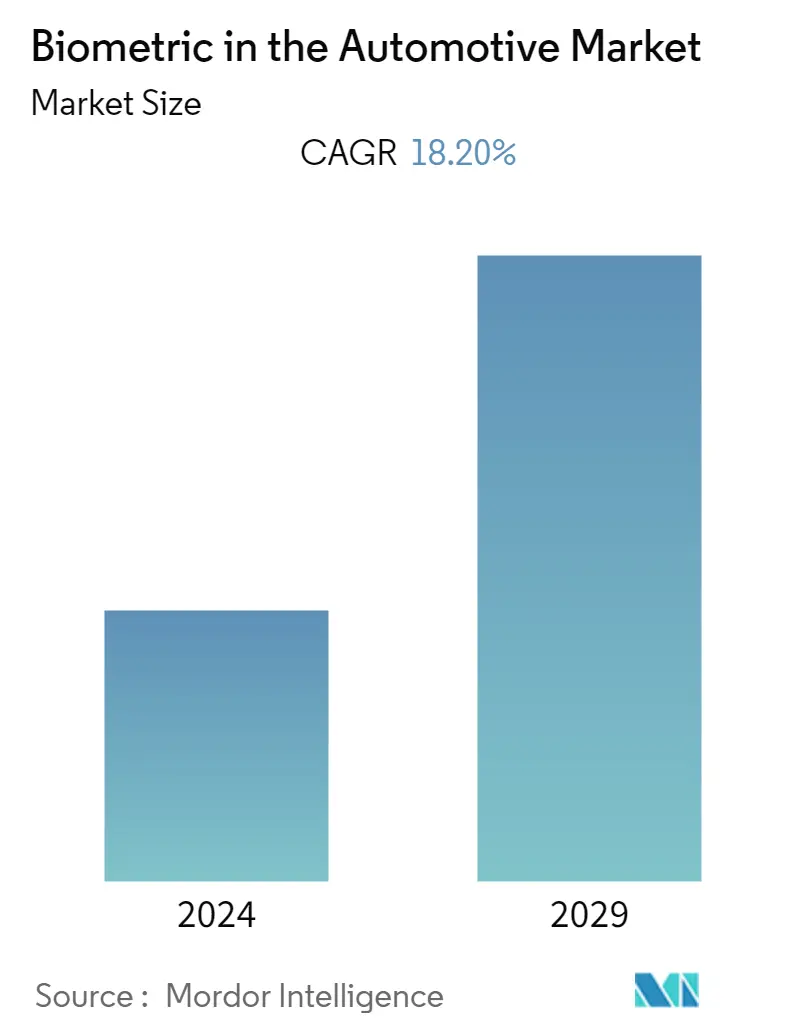Market Size of Biometric in the Automotive Industry

| Study Period | 2019 - 2029 |
| Base Year For Estimation | 2023 |
| CAGR | 18.20 % |
| Fastest Growing Market | Asia Pacific |
| Largest Market | North America |
| Market Concentration | Medium |
Major Players
*Disclaimer: Major Players sorted in no particular order |
Need a report that reflects how COVID-19 has impacted this market and its growth?
Biometric in the Automotive Market Analysis
The global biometric in the automotive market is expected to register a CAGR of 18.2% during the forecast period. After the increased adoption of biometrics in electronic devices, the applications of biometrics in automotive vehicles have also been gaining traction in recent years. Yet the implementation of this technology has been limited to the premium vehicle segment, but in recent years, its applications are estimated to enter the general personal vehicle segment due to its better vehicle security and other accessibility advantages.
- In the automotive industry, the application of biometrics lies in various areas, including access control for starting a vehicle using various biometric scanners, enabling personalized vehicles for the users to allow drivers and passengers to call up playlists, contacts, and preferred apps. The application of these biometrics in automotive vehicles is expected to increase during the forecast period.
- Iris recognition is considered a reliable and accurate biometric technique for authentication of the driver in automobiles, and players are approaching with more features, such as securing the multiple services offered through the gateway. In April 2022, Hyundai filed a patent for a system that uses iris scanning technology to verify the driver's identity when they get into the vehicle. This system also prevents someone from starting the vehicle unless there is a biometric match.
- Recently, EyeLock announced a collaboration to apply its iris biometric authentication technology to the SiriusXM e-Wallet in a highly secure, touchless gateway prototype. Drivers and passengers will be able to find, pay, or pre-pay for coffee, gas, movie tickets, or parking while on the go. It helps to eliminate driver distractions during transaction processes, capturing driver or passenger iris biometrics with EyeLock's custom-designed, visor-mounted prototype. Such new technology caters to a new future trend in the biometric application in the iris recognition segment.
- Facial recognition has been gaining importance in the automotive sector. Automaker Subaru introduced facial recognition into its latest Forrester model. The system combines an infrared LED and a camera to monitor the driver for signs of inattention or sleepiness, warning them if needed. The system recognizes up to five individual drivers, so settings and preferences can be automatically adjusted for each person.
- Furthermore, various automobile players have also implemented fingerprint technology to unlock their cars. Fingerprint identification is majorly accepted in biometric identification as the probability of finding two same fingerprints is one in 64 billion, even with twins, increasing its credibility.
- Automobile players, such as Hyundai Motor, use fingerprints where multiple drivers can register theirs. Depending on the fingerprint, the car will automatically adjust seat positions and the angle of the rearview mirrors. Hyundai says its method to add fingerprint technology uses the human's capacitance where the reader differentiates and prevents hacking or any forged fingerprints. It has been said that the reader has an error rate of 1 in 50,000.
- Due to the COVID-19 pandemic, the production unit of automotive has fallen steeply at the global level. According to the European Automobile Manufacturers Association, EU-wide production losses due to factory shutdowns amount to at least 2,446,344 motor vehicles so far. In particular, biometric systems have been brought into the spotlight as a key technology for early detection, patient screening, and public safety monitoring in an effort to contain the spread of COVID-19; however, in the automobile sector, the demand reduced drastically due to low production of automotive and disruptions in the supply chain.

